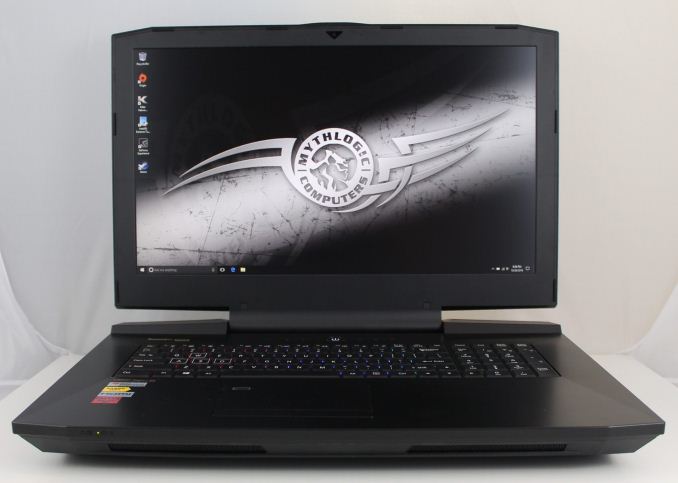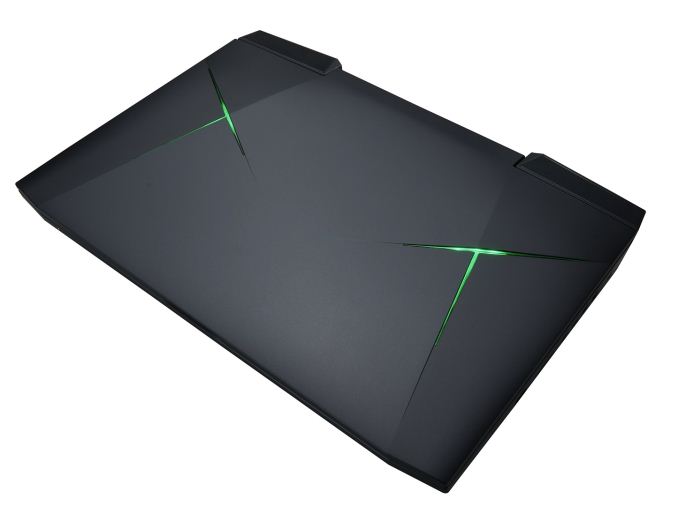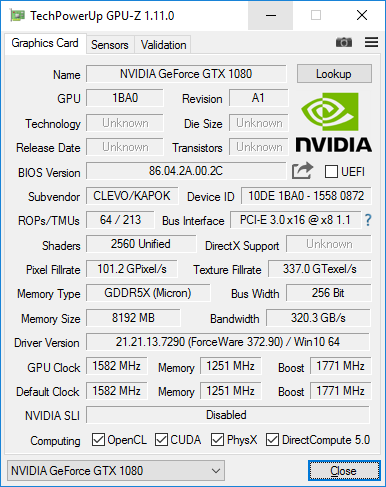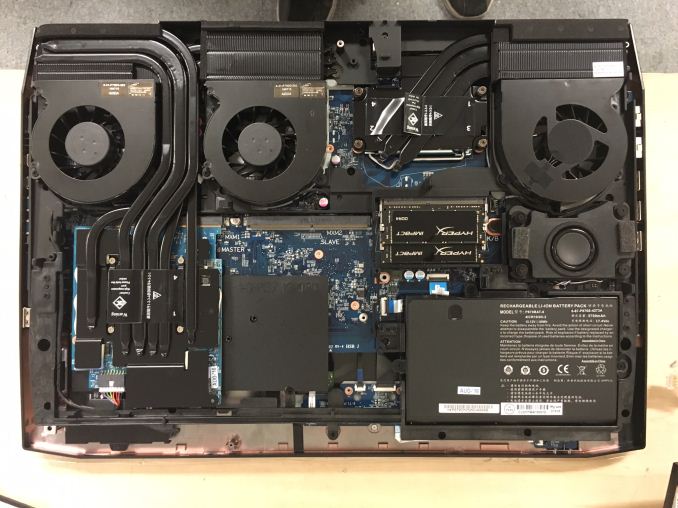The Clevo P870DM2 / Mythlogic Phobos 8716 Laptop Review: DTR With GTX 1080
by Brett Howse on October 27, 2016 2:00 PM EST
Sometimes there is no substitute for performance. Most of the laptop market is focusing on thin and light designs, with companies attempting to outdo each other by shaving a millimeter or two off of their laptop z-height compared to the competition. But in the Desktop Replacement (DTR) category, there are no such concessions. Clevo is one of the few laptop makers that is in the DTR market, and thanks to the assistance of Mythlogic, we have the Mythlogic Phobos 8716 DTR for review today. As a Clevo, the model would be P870DM2.
Let’s cut right to the chase. The Mythlogic Phobos 8716 is a beast of a laptop, and really should rarely be used in your lap. It is designed for someone who needs the ultimate performance, but still needs something more portable than a full desktop. This is a 17.3-inch display packed into a chassis that is 47.2 mm thick (1.86”) and weighs in at 5.5 kg (12.13 lbs) with a single GPU. And yes, you can opt for two GPUs, which ups the weight and moves you into the land of ridiculous.
Mythlogic offers a couple of choices of CPU and GPU, but all the CPUs are desktop parts, from the Intel Core i5-6400 65-Watt processor up to the Intel Core i7-6700K 91-Watt processor (as we have in the review unit). This is the same unlocked quad-core as you would find in any high performance desktop. On the GPU side, the base model is a mere GTX 1070, or step up to the GTX 1080, or either card in SLI. If you get dual GTX 1080 GPUs, be prepared to have two AC outlets handy for the dual 330-Watt AC Adapters. Mythlogic also supports overclocking on all of the components. There are four SODIMM slots for up to 64 GB of DDR4 memory as well. This is well and truly a desktop class computer packed into a (somewhat) portable chassis.
The display options also need mentioning too. The standard panel is a 1920x1080 IPS display with a 120 Hz refresh rate. That should be a very significant upgrade for almost anyone, up from the ubiquitous 60 Hz laptop displays. They are also offering a 2560x1440 AHVA 120 Hz panel with G-SYNC option, and a 3840x2160 60 Hz AVHA panel which also includes G-SYNC.
| Mythlogic Phobos 8716 / Clevo P870DM2 | |
| As Tested: 6700K, 16GB (2x8) 2400 DDR4, 1x1080, 256GB Samsung 950 Pro m.2, 120Hz FHD, $2980 USD |
|
| CPU | Intel Core i5-6400, 4C/4T, 2.7-3.3 GHz, 6MB Cache, 65W TDP |
| Intel Core i5-6500, 4C/4T, 3.2-3.6 GHz, 6MB Cache, 65W TDP | |
| Intel Core i5-6600, 4C/4T, 3.3-3.9 GHz, 6MB Cache, 65W TDP | |
| Intel Core i5-6600K, 4C/4T, 3.5-3.9 GHz, 6MB Cache, 91W TDP | |
| Intel Core i7-6700, 4C/8T, 3.4-4.0 GHz, 8MB Cache, 65W TDP | |
| Intel Core i7-6700k, 4C/8T, 4.0-4.2 GHz, 8MB Cache, 91W TDP | |
| GPU | NVIDIA GTX 1070 8GB, 2048 CUDA Cores , 1442 - 1645 (Boost) MHz Also available as 2 x SLI |
| NVIDIA GTX 1080 8GB, 2560 CUDA Cores, 1556 - 1733 (Boost) MHz Also available as 2 x SLI |
|
| Memory | 4 SODIMM Slots, 64 GB Max, up to 3000 MHz |
| Display | 17.3" 1920x1080 IPS 120Hz Optional 2560x1440 AHVA 120 Hz w/G-SYNC Optional 3840x2160 AHVA 100% Adobe RGB w/G-SYNC |
| Storage | 2 x 9.5mm 2.5” SATA 2 x m.2 Slot (SATA or 4xPCIE) |
| I/O | 5 x USB 3.0 Ports (1 x powered USB port, AC/DC) 2 x USB 3.1 / Thunderbolt 3 Port (Type-C) 1 x HDMI 2.0 output Port (with HDCP) 2 x DisplayPort 1.3 output Ports SD Card Slot 1 x Headphone Jack 1 x Microphone Jack 1 x Line-in Jack 1 x S/PDIF (digital) (Shared with headphone jack) 2 x Killer E2400 RJ-45 LAN (10/100/1000Mbps) |
| Dimensions | 428 x 308 x 47.2 mm 16.85 x 12.12 x 1.86 inches |
| Weight | 5.5 kg / 12.13 lbs (single GPU) |
| Battery | 82 Wh, 330W / 230W W AC Adapter |
| Wireless | Intel Dual Band Wireless-AC8260 2x2:2 with Bluetooth 4.1 Killer Wireless-AC 1535 2x2:2 with Bluetooth 4.1 |
| Price | $2255 - $5000+ |
There is no shortage of ports, with five USB 3.0 ports, two USB 3.1 Type-C ports with Thunderbolt 3, HDMI 2.0, two DisplayPort 1.3, and separate audio jacks for the headphone, microphone, and line-in. It also features a Killer E2400 Ethernet adapter, and that wired connection can be paired with either the Killer 1535-AC wireless to support Killer’s DoubleShot Pro, or Intel’s Dual Band Wireless-AC 8260 card if you prefer their solution.
With a starting price of $2255, the Mythlogic Phobos could never be considered inexpensive, but on the performance per dollar metric, there are few laptops that offer this kind of performance period, let alone for the price.













61 Comments
View All Comments
Morawka - Thursday, October 27, 2016 - link
i dont think nvidia is done with pascal mobile parts. I'm sure they will release some midrange stuff here soon.Meaker10 - Friday, October 28, 2016 - link
The vapor chamber cooler on the SLI 1080 config can keep both cards at 1910mhz core clocks during gaming with both cards loaded with the right mounting :)The_Assimilator - Friday, October 28, 2016 - link
Given that Pascal is probably the last gasp of the Maxwell architecture, I think it was a simple matter of nVIDIA wanting to push it as far as it could go. (That, and wanting to crush AMD Polaris.) So slightly higher TDP was probably not a concern of theirs, especially given how much more performance you're getting for that power.As for your desire for potentially slower cards that draw even less power, I'm actually with you on that one. I'm tired of seeing "low-end" cards that require dual-slot cooling and additional power connectors. Bloody hell, back in the day, the 8800 GT was near the top of the hill in terms of performance and it was a single-slotter with 1 PCIe power connector.
BillyONeal - Thursday, October 27, 2016 - link
I'm happy they stopped with the mobile GPU mess. I was sick of looking at laptops and having no idea how they'd perform because the nomenclature of the desktop and mobile parts were different, and nobody did reviews or had good benchmarks of the mobile parts.Sure, due to thermal constraints the mobile implementations are going to perform a little bit worse than desktop equivalents in some circumstances, but not ~50% worse as was common just a few years ago.
Spunjji - Friday, October 28, 2016 - link
We have a new problem, though - actual performance is extremely dependent on cooling implementation due to the huge delta in boost clocks these things can produce.It's great from the perspective of getting the most possible out of your own device, but from a view of trying to buy a notebook it's a bit nightmarish.
BillyONeal - Friday, October 28, 2016 - link
Sure, but that was also true with "m" branded GPUs. Crappy cooling will still tank perf.versesuvius - Thursday, October 27, 2016 - link
DTR or overspeced (overspect ?) AIO?Michael Bay - Thursday, October 27, 2016 - link
Top cover. Just why.anactoraaron - Thursday, October 27, 2016 - link
"But Mythlogic also adds their own tools to do a couple of things. Mythlogic has a control center..."Correct me if I'm wrong but that looks like the standard Clevo control center. I have that on my 2 year old Clevo W370ss. I don't have the other software, but from the ui design I would assume that it is Clevo software also. Nothing looks to be exclusive to Mythlogic to me.
anactoraaron - Thursday, October 27, 2016 - link
Also after seeing the performance relative to the 980M, that new surface aio looks even less worth the money. MS didn't need to go full 1080, but a 1070 or even a 1060 would have been a better choice. Don't get me wrong, but with the surface devices it seems to me like they keep missing the mark, and I keep telling myself 'maybe they'll get the next one right and I'll pick one up.' Only to get let down every year.